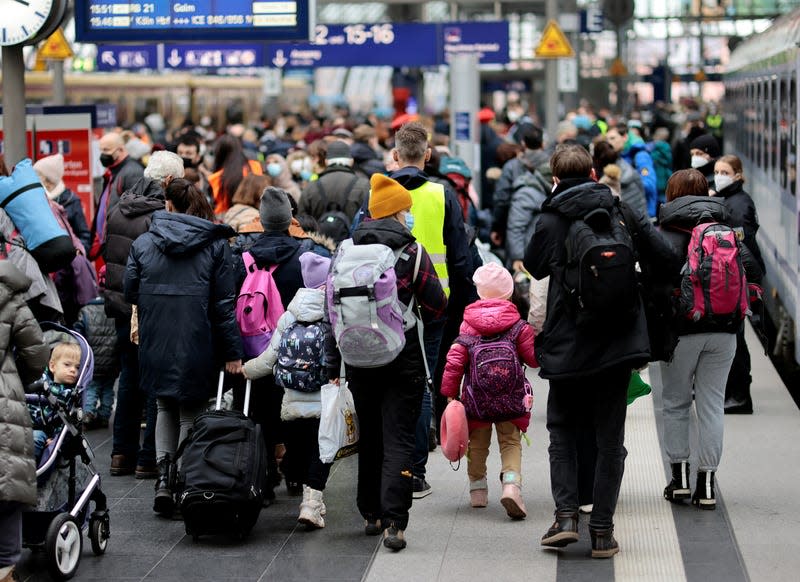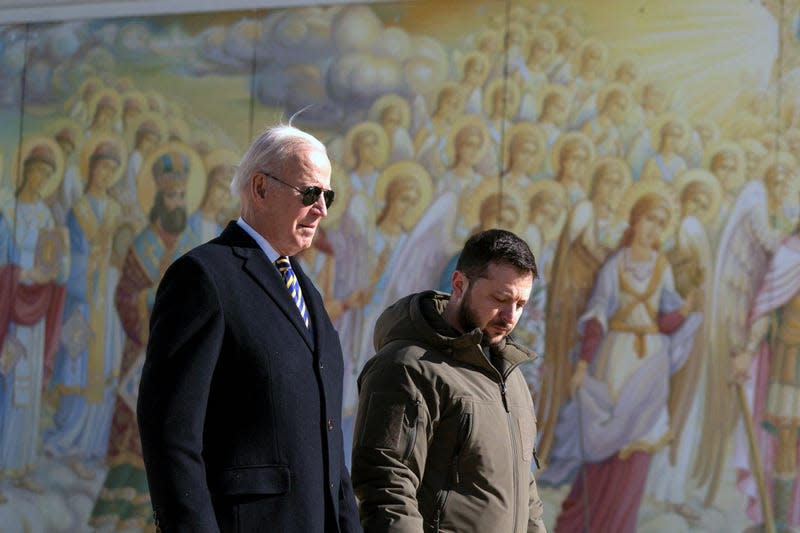Ukrainians keep returning home as the war enters its second year

Ukrainian refugees arrive in Berlin in March 2022.. A year later, some of them will have returned to Ukraine.
Millions of Ukrainians fled their country after Russia’s invasion last February. But as the conflict enters its second year with no end in sight, millions of others have also become “returnees,” moving back to their homes, often despite continued danger, and often with their children.
Just over 8 million people have left Ukraine since the full-scale Russian attack began on Feb. 24, 2022, according to data released this month by the UN High Commission for Refugees (UNHCR). Additionally, within Ukraine, about 5.4 million are internally displaced—largely those who have moved from the heavily-besieged cities in the East to the relative safety of Western cities like Lviv—according to separate data collected by The International Organization for Migration (IOM), also released in February 2023.
Read more
In its newest study, the IOM said it believes 5.6 million Ukrainians have returned after a long absence. The IOM defines returnees as those who moved away for at least two weeks and have gone back to their “habitual residence,” whether those people left Ukraine or were displaced within it.
The biggest contingent, UNHCR notes, is older people who may have struggled to integrate abroad. But there are also young idealists and those who want to be reunited with partners and their families. According to IOM, a quarter of those returning are children under the age of 18.
Returning to a warzone
Natalya Ievtushenko, who is 35 and ran her own successful travel business until the war started, was visiting her parents outside the Ukrainian capital Kyiv when Russia invaded. As a single mother with a toddler, she rushed to find a way out of the country, taking the few clothes and documents she had with her and traveling in a friend’s car across two borders to the Czech Republic. She stayed with her friends’ family for three weeks, then moved into a hotel. A month into the war, she decided to return to Ukraine.
While Ievtushenko said she doesn’t criticize anyone’s decision to leave, she feels a duty to stay in Ukraine. “We need to raise up, and to support business here, to support economics,” she said. “We understand that it’s a very bad situation, but we need to do something, we need to create something here, to try to show another view: That life here exists.”
Ievtushenko lives in a modern block that doesn’t have gas for cooking. She bought a camping stove so she can cook when the electricity turns off. In October, she was accepted onto an internship program at Visa. She works around the blackouts, making sure to charge her laptop and phone when she has electricity. When air-raid sirens sound, she and her 3-year-old son go to a nearby shelter, taking food, water, and coffee with them.

A Ukrainian woman holds her baby while at a refugee centre for internally displaced people.
Fear, intense early on, has waned as the war has progressed. Ievtushenko now recognizes that drone attacks will mostly be countered by Ukraine’s air defenses. Her son points to planes in the sky with excitement knowing they’re Ukrainian defense forces. If he became frightened, Ievtushenko said, it could prompt her to leave. For now, they stay, despite the lack of kids’ activities in the city, like the swimming pool the city can’t heat due to the frequent power outages.
Ievtushenko daydreams not about permanent escape, but about a trip like the ones that, as a woman who owned a travel firm, she often took before the war. “I don’t want to go away [permanently],” she said. “I just want to go somewhere on holiday. I want to go somewhere just to see friends, to do some stuff that normal people do. To sleep in a safe place, to go for coffee, to go see the sea, to go to the beach, to go to museum, or, I don’t know, to dance somewhere.”
Why are Ukrainians moving back to Ukraine?
In the current reality, Ukrainians have to make complex decisions. Most abandoned homes that, if still standing, have to be maintained. One Ukrainian mother living in London explained that, though she now only has a few hours’ work a week, she still has to pay for utilities and nursery school back in Ukraine, as well as all the expenses of life in one of the most expensive cities in the world.
Some people return because, while life in Ukraine is hard, life as a refugee is harder, including the difficulty of finding work, operating in a second language, finding housing and schools, and all the other minutiae of setting up a whole new life. Many also have loved ones in Ukraine—like Ievtushenko, whose parents care for one of their own parents and didn’t want to leave.
For Denys Panin, a Ukrainian who’s lived abroad in New York for seven years, convincing his 64-year-old mother to leave in the first place was difficult. “If not for me calling her crying and sobbing and trying to convince her to leave, she probably wouldn’t have left,” he said. Panin was able to find his mom an apartment in the Czech Republic through Prague Pride, an organization helping LGBTQ+ Ukrainians and their families find housing.
Panin’s mom is headed back to Ukraine this month to be closer to family and friends. “I also feel like she felt guilt for not being there, which is a pretty common thing,” he said. “A lot of people in the initial days, weeks, or months have this feeling that their loved ones are suffering and going through challenges every day.”
Who’s winning the Ukraine war?
The war is entering a turning point. Mikhail Alexseev, a political science professor at San Diego State University and a former Ukrainian journalist and Kremlin correspondent, says that Russia miscalculated at the beginning of the war, assuming that Ukraine would fall quickly. As a result, it’s had to change its strategy in recent months.
“They didn’t realize that Ukraine became an independent, resilient and thriving society,” said Alexseev. “And that this society, regardless of who leads it, is going to resist that invasion and is not going to accept the Russian rule.”
Instead of sending in big columns of tanks that are vulnerable to attack, as it did initially, Russia has now created a line of forces about 1,000 miles long to move across the country at a glacial pace.
With Ukraine not having gained new territory since October, Putin’s new strategy seems to be to gradually deliver Ukraine to the Kremlin, with the hope that the West and rest of the world tires in their support of Ukraine, Alexseev said.
Yet US President Biden’s surprise visit to Kyiv earlier this month signals the opposite. It also suggests that the US is calling Putin’s bluff on his threats of using nuclear tactics. Alexseev said he believes it is highly improbable that Russia would use weapons of mass destruction in combat, since this would undermine Putin’s strategy of waiting for Western countries to lose interest in the war.

U.S. President Joe Biden walks with Ukrainian President Volodymyr Zelenskiy at St. Michael’s Golden-Domed Cathedral during an unannounced visit to Kyiv, Ukraine.
American and European military assistance has strengthened Ukraine’s air defenses to the point that the Ukrainians are now knocking down 75% to 80% of Russian missiles, Alexseev added. This increased sense of safety has enabled Ukrainians to return home.
Economic opportunities will also bring Ukrainians back into the country, said Alexseev. There’s a push underway to rebuild the parts of Ukraine that have been demolished, which will produce more construction jobs in the country.
International investment in the country would also help Ukrainians return. The Ukrainian hryvnia has buckled while Ukraine’s GDP declined by 35% in 2022. The Ukrainian government has provided financial assistance to people in need and families of those fighting on the front lines, but it also recently had to cut the pay of soldiers fighting in the war because of its stretched budget.
At the same time, jobs programs in various EU countries will allow Ukrainians to make it feasible for Ukrainian migrants to stay abroad if they want to.
Ukrainians are moving under better conditions than other refugees in the recent past, said Shelly Culbertson, a RAND Corporation senior policy researcher specializing in migration. The EU has implemented policies that give Ukrainians temporary protection status, allowing them to work and rent apartments for three years.
If Ukraine wins the war, then getting Ukrainians to come back may be a large part of rebuilding the nation. Culbertson’s research, which has spanned all conflicts since 1980, revealed that 10 years after a conflict, 30% of refugees on average returned to their home countries.
“There are no robust solutions that are consistent for helping people to return, it turns out the international community is actually just not very good at making that happen,” Culbertson said.
Still, this isn’t how most Ukrainians surveyed by UNHCR feel at the moment. Only 5% of them foresee never being able to return home, while 12% plan to move back permanently sometime in the next three months—a sure sign that the rebuild is already in progress.
More from Quartz
Sign up for Quartz's Newsletter. For the latest news, Facebook, Twitter and Instagram.


